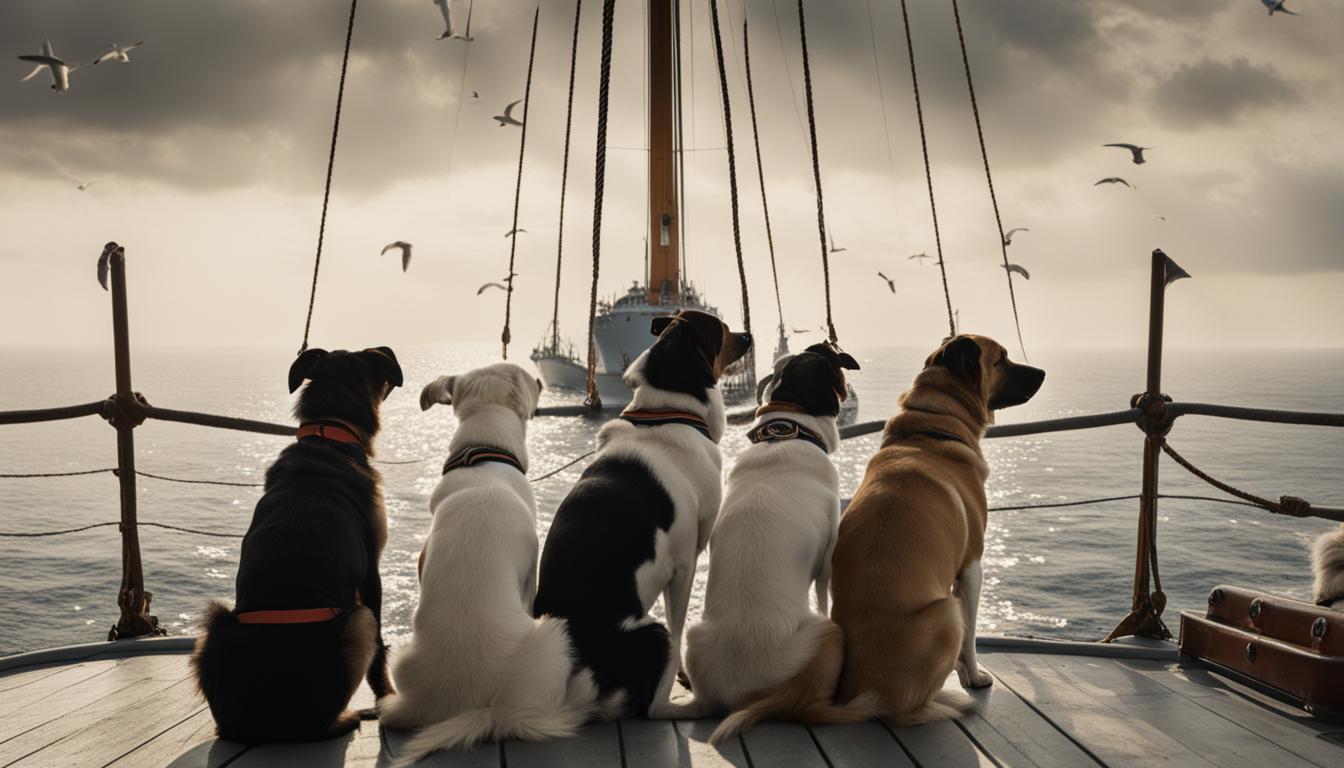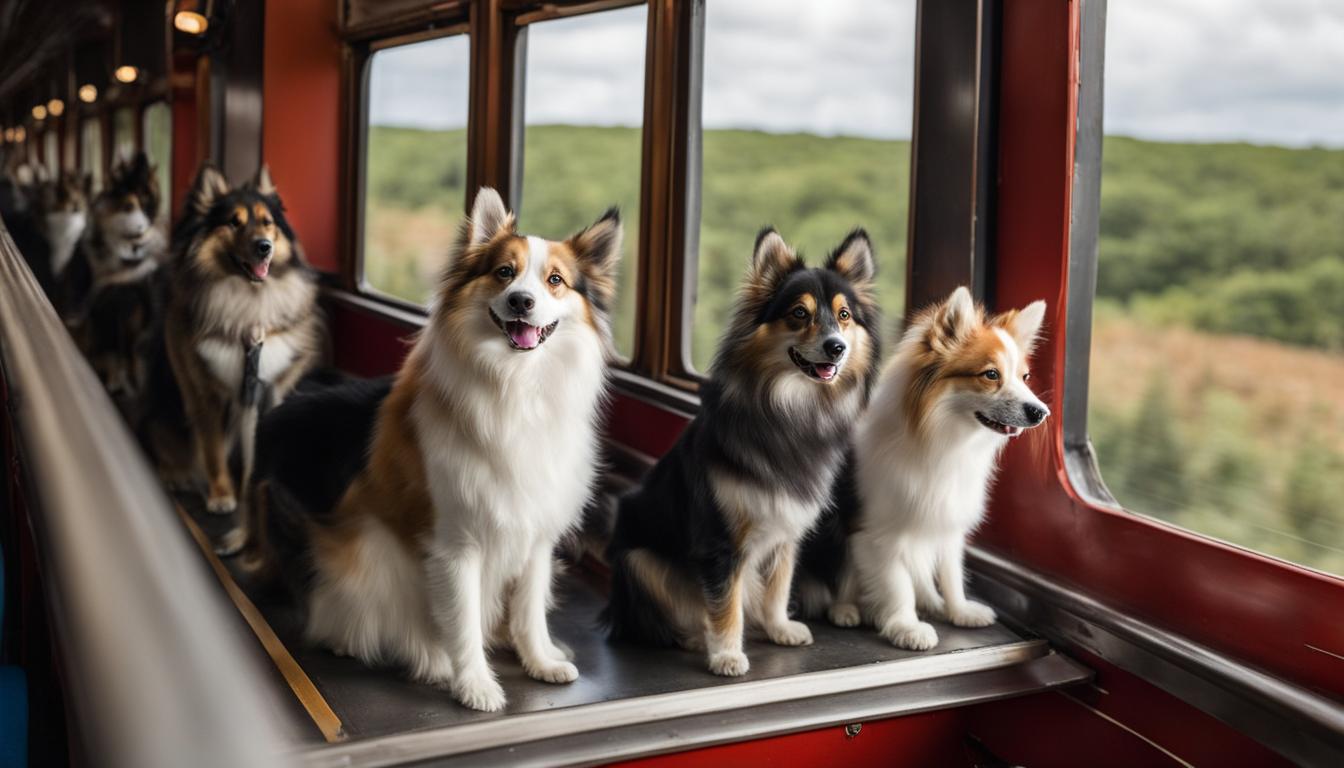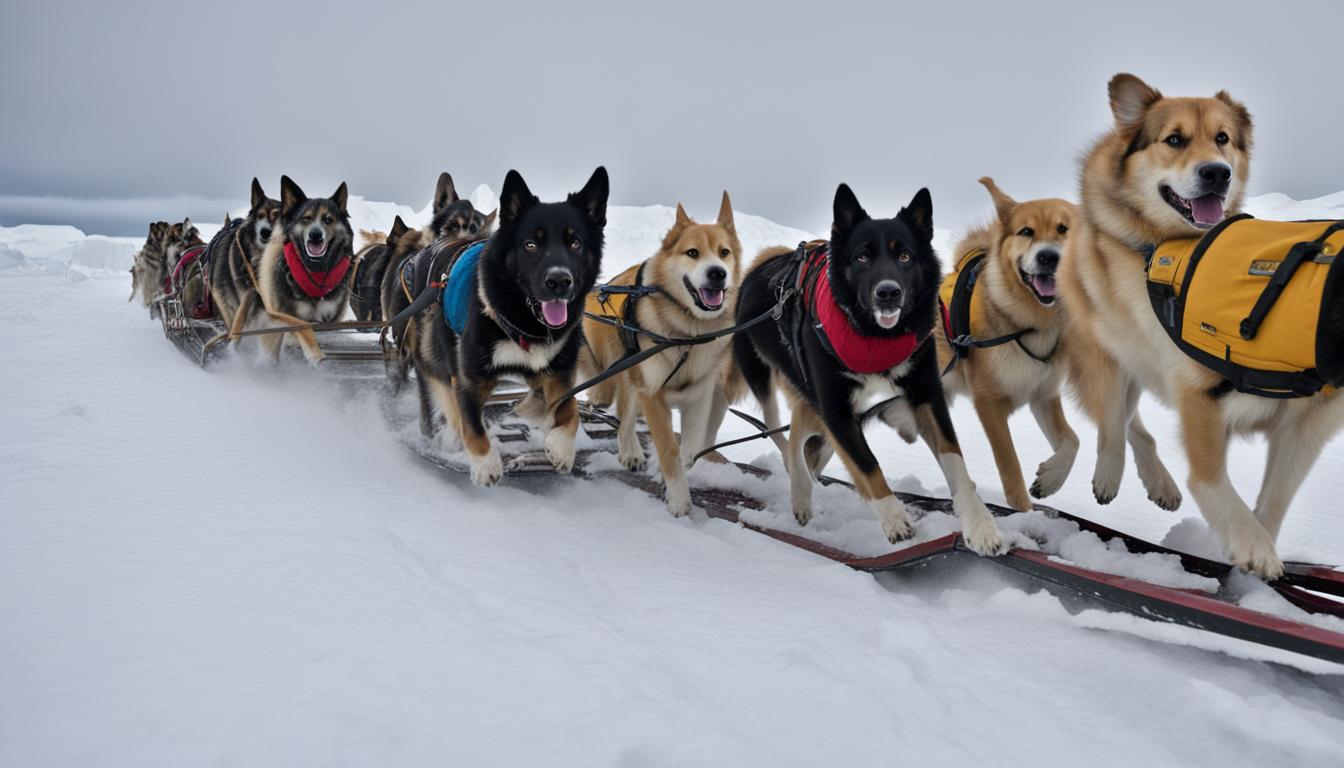Humans have been using boats to navigate the seas for thousands of years. Throughout maritime history, dogs have played a vital role as companions to sailors. From warding off rodents to providing emotional support on long voyages, dogs have been an integral part of seafaring life. Cats and even chickens have also made appearances onboard ships. While the presence of pets at sea is often overlooked, recent efforts by maritime museums have started shedding light on the history of animals at sea.
Key Takeaways
- Maritime dogs have been companions to sailors throughout history.
- They have served practical roles such as warding off rodents.
- Dogs have provided emotional support to sailors during long voyages.
- Maritime museums are increasing awareness of the history of animals at sea.
- Pets at sea have been more than just dogs, with cats and chickens also making appearances.
Dogs in Maritime War
Throughout maritime history, dogs have not only been loyal companions but have also proved themselves to be brave and valuable assets in maritime conflicts. These canine heroes have left an indelible mark on seafaring culture, with their courage and service being celebrated and remembered to this day.
Legends of Maritime Dogs
One of the most legendary maritime dogs is Sinbad, a mixed-breed rescue who became a media sensation during World War II. Sinbad served as the mascot aboard the US Coast Guard vessel Campbell and his mischievous antics brought smiles and laughter to the crew. Despite his playful nature, Sinbad provided much-needed comfort and companionship in the midst of the war’s perils.
“Sinbad the dog was one hell of a sailor.”
Another notable maritime canine is Simon, a cat who served on a British Royal Navy sloop during the Chinese Civil War in 1949. Despite not being a dog, Simon’s bravery and loyalty earned him the prestigious Dickin Medal, the highest honor bestowed upon animals for their wartime contributions.
Maritime Dog Training
The training of maritime dogs was a crucial aspect of their involvement in wartime efforts. These dogs were taught to perform a variety of tasks, including search and rescue missions, detecting mines, and alerting their human counterparts to potential dangers. Their specialized training made them invaluable assets on ships, providing an extra layer of security and assistance to the sailors.
| Maritime Dog Breeds | Function |
|---|---|
| German Shepherd | Search and rescue, guarding |
| Labrador Retriever | Detection, tracking |
| Belgian Malinois | Patrol, apprehension |
| Boxer | Guarding, messenger duties |
These historical maritime dogs and their training serve as a testament to the importance of animals in maritime warfare. Their loyalty, courage, and unique abilities made them vital contributors to the success and safety of naval operations.
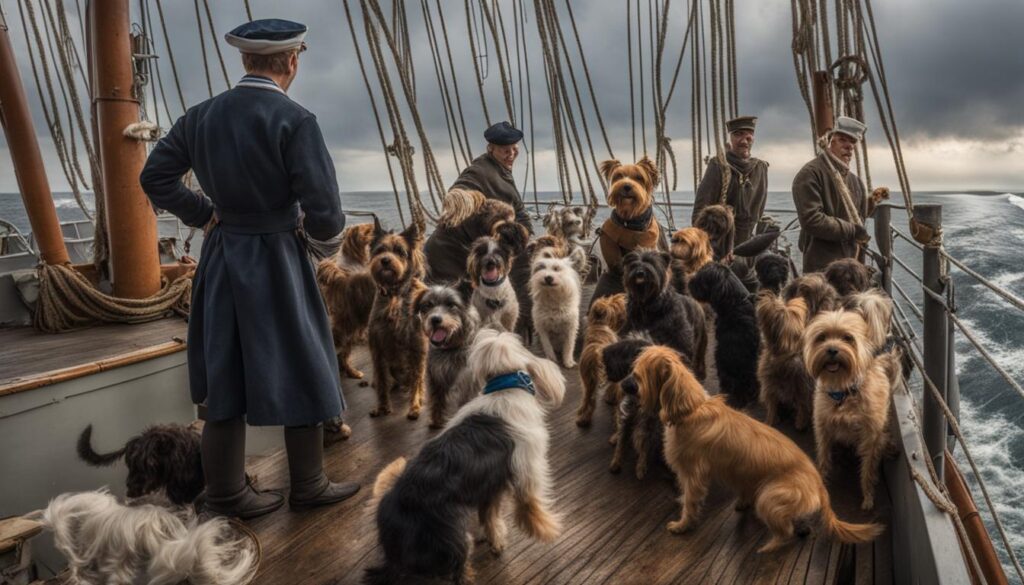
In Conclusion
The role of dogs in maritime war is an often overlooked but significant part of maritime history. From the legendary tales of Sinbad and Simon to the specialized training of maritime dog breeds, these canines played a crucial role in providing comfort, companionship, and assistance to sailors in times of conflict. Their stories remind us of the enduring bond between humans and dogs, and the extraordinary contributions these furry companions have made throughout history.
Famous Maritime Dogs: Providing Emotional Support at Sea
Maritime dogs have not only served practical roles onboard ships but have also offered emotional support to sailors throughout history. These beloved companions have brought comfort and a sense of normalcy to sailors facing the challenges of long and arduous voyages.
One such famous maritime dog is Kirri, a Persian kitten-turned-cat who found herself aboard the Finnish sailing vessel Parma. Kirri’s presence provided companionship and solace in the midst of the harsh conditions of life at sea. Sailors, often separated from their families and confronted with the unpredictable nature of their maritime endeavors, formed a deep bond with these loyal and affectionate creatures.
“The faithful presence of a dog can be a great morale booster for sailors,” says maritime historian Dr. Rebecca Thompson. “They offer unwavering companionship and unwavering support in the face of the challenges and isolation of maritime life.”
Similar stories of legendary maritime dogs echo throughout history, testament to the profound impact they had on the well-being of sailors. From providing a friendly face during times of loneliness to offering a source of comfort during stormy weather, these four-legged friends played an important role in keeping the crew’s spirits high.
The Importance of Maritime Dogs as Emotional Support
The emotional support offered by maritime dogs cannot be understated. Their presence onboard provided a sense of stability and familiarity, creating a home away from home for sailors as they battled the open seas. These loyal companions were an integral part of the crew, earning the respect and admiration of their human counterparts.
| Maritime Dog Legend | Role | Notable Contributions |
|---|---|---|
| Kirri | Emotional Support | Provided companionship and solace during long voyages |
| Sinbad | Mascot | Boosted morale and served as a symbol of camaraderie during World War II |
| Mrs. Chippy | Mascot | Brought joy and companionship to the crew of the Endurance expedition ship |
As maritime museums and enthusiasts strive to preserve the history of these remarkable animals, the legacy of maritime dogs continues to inspire and captivate. Their stories serve as a reminder of the deep bond between humans and animals, even amidst the vast expanse of the open ocean.
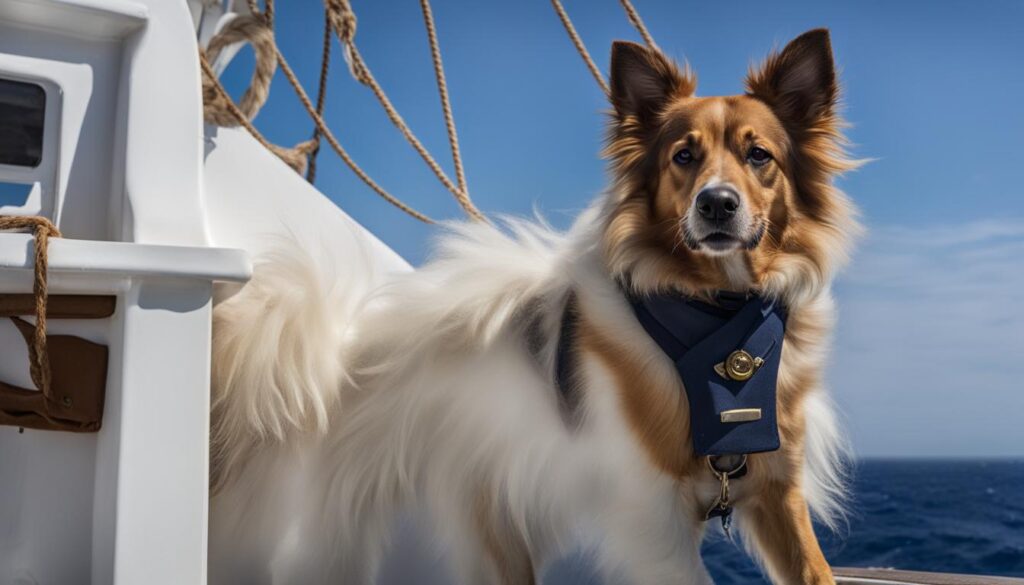
Join us in the next section as we uncover the fascinating role of maritime dogs in times of war and conflict.
Conclusion
Throughout maritime history, dogs have been much more than just furry companions on seafaring journeys. They have provided valuable assistance, emotional support, and endless entertainment to sailors across the globe.
From fending off rodents to lifting spirits during treacherous voyages, maritime dogs have been an integral part of maritime life. Their stories, like that of Simon the heroic cat and Sinbad the mischievous mascot, exemplify the bravery and loyalty of these beloved animals.
Although the tradition of dogs on ships may have declined in modern times, their legacy lives on in the tales and historical accounts of their adventures. Maritime museums and enthusiasts continue to pay homage to these special animals, ensuring that their contributions to maritime history are not forgotten.
So, the next time you explore a maritime museum or delve into the history of seafaring, take a moment to appreciate the important role that dogs played in shaping our maritime heritage. Their wagging tails and unwavering loyalty are a testament to the enduring bond between humans and their four-legged friends at sea.
FAQ
Why have dogs been important in maritime history?
Dogs have played various roles in maritime history, including providing companionship to sailors, helping with practical tasks like rodent control, and offering emotional support during long voyages.
Have dogs ever been recognized for their contributions at sea?
Yes, some dogs have been awarded prestigious medals, such as Simon the cat who received the Dickin Medal for his service in the British Royal Navy. Sinbad, a mixed-breed dog, became a media sensation during World War II for his antics as a mascot aboard a US Coast Guard vessel.
How did dogs offer emotional support to sailors?
Sailors often faced isolation and uncertainty at sea, and dogs provided comfort and companionship in such challenging conditions. Having a loyal and loving canine companion helped sailors feel connected and provided a sense of normalcy.
Are there any famous maritime dogs?
Yes, there are several famous maritime dogs, such as Mrs. Chippy who was aboard the Endurance expedition ship and Kirri, a Persian kitten-turned-cat aboard the Finnish sailing vessel Parma. These dogs became cherished members of the crew and earned the respect and admiration of their human counterparts.

